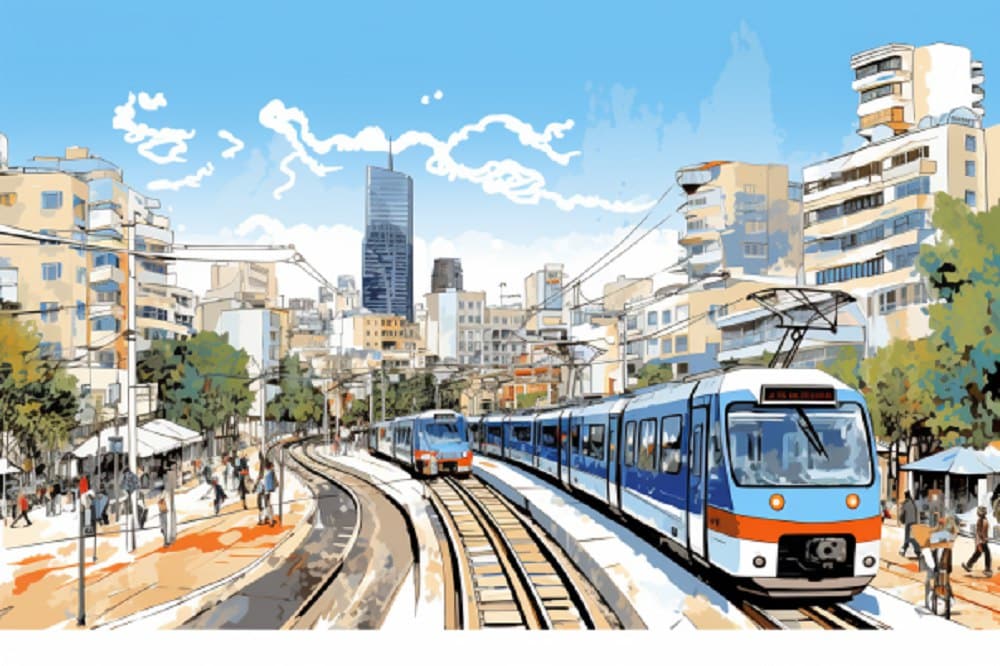It is the dawn of a new era in Tel Aviv as its Light Rail commenced operations for the first time earlier today, setting the stage for a transformative impact on the city’s transportation landscape. With an estimated daily ridership of 234,000 passengers traversing the 24 km Red Line, this monumental project aspires to unite communities from Petah Tikva, Bat Yam, Bnei Brak, Ramat Gan, and Tel Aviv-Jaffa.
A Blend Of Form And Function
To alleviate the notorious traffic congestion that has long plagued the city, the Tel Aviv Light Rail will redefine urban mobility and accessibility. While most rail operations will be on the city’s surface, there are also ten strategically placed underground stations.
This grand endeavor was orchestrated by the National Transportation Authority (NTA), with Tevel at the helm of construction. The result is an impressive functional system that redefines how Tel Aviv’s residents and visitors navigate the city.
Mayor Ron Huldai, a fervent advocate for the project from its inception, envisions the light rail as a transformative milestone for Tel Aviv. Huldai opined that “in six years, the city will be networked with 64 stations, meaning there will be a train station within 500 meters of every person in the city.”
Nonetheless, the journey toward this transformative achievement was not without its trials and tribulations. The project surpassed its initial projected fund of NIS 10.7 billion, with costs rising to NIS 18.8 billion, establishing it as Israel’s most expensive infrastructure project.
Meanwhile, the increase in material and labor were two primary factors that caused the fund surge to complete the project. By comparison, similar projects in the Far East have been completed with lower costs and quicker implementation due to fewer regulatory constraints.
The complexities in completing the project go beyond the tangible elements of construction. Avi First, NTA’s spokesperson, explained that the diversity of interests and demands created roadblocks, leading to delays and additional costs.
Impacts On Business And Community
The Tel Aviv Light Rail project extends beyond its physical impact. It includes the stories of local businesses and residents directly affected by the construction. Business owners, particularly those near the construction project, stated that they encountered a sharp decline in foot traffic and profitability.
Ben Mishkit, a tattoo artist, lamented the challenges he faced during construction because of his shop’s location. “We’re a tattoo shop, so we rely on foot traffic. It damaged our profits and ability to draw in new business,” Mishkit revealed.
Café and bar owners along Allenby Street, such as Avi Avital, echoed similar sentiments. Analysts predicted that local businesses in the construction area lost nearly 40% of their profits while the construction project was ongoing.
They added that the soul of Tel Aviv, epitomized by these streets, was temporarily overshadowed by the disarray of construction. Residents also bore witness to the transformation that took place at that time. They said the construction noise and visual disruptions became a part of their daily routines.
While some expressed concerns about the severe changes that might follow the project’s completion, others remained optimistic about the convenience and innovation that the light rail would introduce to their lives.
There were also discussions about the operations of the light rail project on Shabbat and holidays. In a city that already operates Shabbat bus lines, the decision not to extend the same courtesy to the light rail provoked debates regarding religious freedom and equality.
Transportation Minister Miri Regev’s assertion that the rail would adhere to the existing Jewish character of the state ignited conversations about the delicate balance between tradition and progress. As Tel Aviv grapples with these challenges and changes, parallels are drawn to the evolution of Jerusalem, where the initial turbulence of a transformative project ultimately gave way to acceptance and integration.
Despite the initial disruptions, the light rail promises to become inseparable from the city’s identity.

